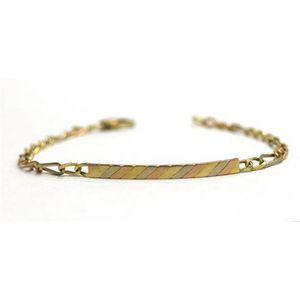1940s Retro Diamond and Synthetic Ruby Cocktail Bracelet
You must be a subscriber, and be logged in to view price and dealer details.
Subscribe Now to view actual auction price for this item
When you subscribe, you have the option of setting the currency in which to display prices to $Au, $US, $NZ or Stg.
- Rose Cut - A flat based cut for a preious stone, leaving the surface covered with triangular facets, usually 24 in total.
It was introduced in the 15th century and popular during the 16th and 17th centuries.
The rose cut was the most popular form of diamond cut until the discovery of the brilliant cut at the end of the 17th century, after which its use declined. - Carat - A carat (abbreviated "ct") is a unit of measurement used to describe the weight of a diamond or other gemstone, and separately is a unit of measurement used to describe the weight of precious metals such as gold,.
For gemstones, one carat is equal to 0.2 grams or 200 milligrams. The weight of a diamond is one of the Four Cs (along with cut, colour, and clarity) that are used to determine a diamond's value.
It is important to note that a diamond's weight does not necessarily correspond to its size. A diamond's cut, which affects how well it reflects light, can make a diamond of a lower weight appear larger than a diamond of a higher weight. Additionally, the carat is not the only factor to determine the value of a diamond, other factors such as clarity, colour and cut are important too.
In the gold industry, the purity of gold is measured in carats (abbreviated "ct"), with 24 karats being pure gold and lower carat numbers indicating a lower purity level. So, for example, 18 carat gold is 18/24 or 75% pure gold, and 12 carat gold is 12/24 or 50% pure gold. - Openwork in Jewellery - Openwork, also known as pierced work, is a decorative technique used in jewellery making that involves removing or cutting out sections of metal from a piece of jewellery to create a pattern or design. This technique can be used in a wide range of jewellery styles, including necklaces, bracelets, earrings, and rings.
Openwork jewellery can be made using a variety of different techniques, including hand carving, sawing, and laser cutting. The design can be simple or complex, and can feature a range of different shapes and motifs, from delicate floral patterns to bold geometric designs.
One of the advantages of openwork jewellery is that it can add visual interest and depth to a piece without adding a lot of weight or bulk. This can be particularly appealing in larger pieces, such as necklaces and bracelets, where heavy materials can be uncomfortable to wear.
This item has been included into following indexes:
- bracelets, gold link type - gold rectangular link 166
-
bracelets, gold with gemstones
- gold with diamonds 1,620
- gold with rubies 222
- bracelets, type - cocktail 98
-
bracelets, with diamonds
- diamond and ruby 156
- diamond with rubies 156
Visually similar items

An 18ct yellow, white & rose gold bracelet, figaro links with a central plaque with alternate pieces of yellow, white and rose gold, length 18 cm Wt 7.7grams

9ct yellow gold Italian bracelet weight: approx 4.66 grams, size: approx 19 cm length

18ct gold necklace Stamped 750, approx 43grams and 40 cm in length

15ct gold gate bracelet by Aroson & Co; alternate links set with a turquoise and a seed pearl. Length 21 cm. Wt. 13.3g.
